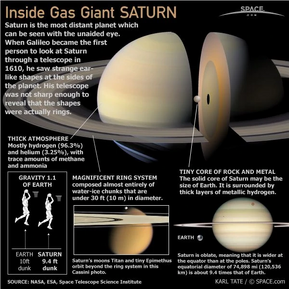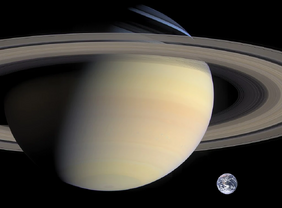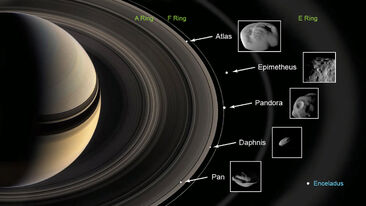Saturn is the sixth planet in our Solar System, as well as the second (largest) gas planet. Saturn is mostly known for its rings, the largest in our Solar System. Every single gas planet has rings but Jupiter's and Neptune's rings are very faint. Saturn's rings are the most extensive and massive rings in the Solar System. Because of this, Saturn is the most famous planet.
Jupiter is larger, denser and more massive than Saturn, but Saturn has 82 moons, 3 more than Jupiter's 79, larger white spots, which are similar to Jupiter's Red Spot and of course, Saturn has much larger, wider, thicker, denser, brighter and iconic rings. Along with Jupiter, Saturn is also known as a Gas Giant (Planet).
Composition[]

Interior of Saturn with several cool characteristics of the ringed gigantic planet.
Atmosphere[]
Saturn's atmosphere is incredibly similar to Jupiter's in composition; majority (75%) hydrogen, minority (24%) helium, methane, ice and others fill the rest. However, even though it is similar, Saturn lacks the necessary elements to form such brightly colored bands, it replaces this with sulphur, nitrogen and oxygen, into molecules like smog. Saturn does not lack these bands, but they are much less visibly present.[1]The layer we can see, the upper cloud deck, has ammonia rich clouds that lay 100 km below the tropopause. Here, temperatures can a staggering -250 °C.
The lower cloud deck, 170 km below the tropopause, is made out of ammonium hydrosulfide clouds, with temperatures of -70 °C, whereas the lowest cloud deck has water clouds, at temperatures of barely 0 °C.[2]On the outside of Saturn's atmosphere is very fast wind, not as fast as that of Neptune.
Interior[]

Saturn vs Earth in size
As it turns out, Saturn is even more alike to Jupiter than we first thought. Due to the immense pressures and temperatures, at a certain level deep into Saturn's internal structure, the hydrogen becomes liquid and then metallic at the core.[3]An ocean of liquid and metallic hydrogen exists deep into Saturn, similar to that of Jupiter. Saturn's interior is also very hot. At it's core, the temperatures can rise up to 15,500°C or more, which is about 3 times hotter than the surface of the Sun.
During the formation of Saturn, the core would have been made first, then, when it reaches the mass of around 30 earths, would it finally be able to attract gasses to form a planet.[4]The rings of Saturn likely formed along with the planet itself, about 4,5 billion years ago, or maybe are just a few million years old. Saturn's internal structure is overall pretty much the same as that of Jupiter. The differrence being that Saturn's interior has great pressures and temperatures that are not as high as those of Jupiter, because Jupiter is larger and more massive than Saturn and has larger gravity.
Rings[]

Saturn's rings with moons illustrated in
Saturn's rings are divided into the A, B, C, D, E, F and G rings, as well as other moon-specific rings. The rings range from being a few thousand km away from Saturn, to being millions of km away, like the Phoebe ring, which is 13,000,000 million km away. Rings are further divided into ringlets, of which there can be hundreds. The rings aren't thin either, some are just meters thin, but some are a few kilometers. The spaces between rings are named after real people, these gaps can go form 400 km to 3 or 4 km in wide.
Inside of these rings are many moons and moonlets, they are formed by collisions and further collisions due to previous collisions, ice, dust and rocks pilling up to form moons over millions of years is one of the reasons why such gaps in the rings occur.[5]The rings, as mentioned above, are made primarily out of ice, dust, rocks, asteroid debris, collision debris and other universal scrap. These clumps of materials can be microscopic or meters tall.[6]
There are 3 hypothesis about how the rings formed. Either 2 moons of Saturn collided, either a meteor hit a moon of Saturn, either a moon of Saturn went to close to Saturn so it did get destroyed because of Saturn's gravity. Then, the materials started orbiting Saturn in circles, breaking up into small cunks of ice and rock and the rings were formed.
Moons[]

Many Moons of Saturn
Saturn currently has 146 known moons, the most moons than any other planet in the Solar System. Jupiter had the most moons but now 20 new were discovered orbiting Saturn, which makes it have 146, 51 more than Jupiter's 95. 53 moons of Saturn's 146 are named with the others waiting for their official names.
Some of it's moons can have life. Enceladus has a liquid ocean under it's surface and Titan also has an ocean under it's surface. Titan also has nitrogen and liquid methane on it's surface. So maybe, just as life on Earth uses liquid water, life on Titan might use liquid nitrogen. Another important moon is Rhea, which is named after Cronus's wife. Cronus was Saturn's Greek equivalent. So many moons and rings of Saturn create their own system with the giant mighty planet in the center.
References[]
- ↑ http://www.esa.int/Science_Exploration/Space_Science/Cassini-Huygens/Saturn_s_atmosphere
- ↑ https://www.universetoday.com/24029/atmosphere-of-saturn/
- ↑ https://www.windows2universe.org/saturn/interior/S_int_compo_overview.html
- ↑ https://www.space.com/18472-what-is-saturn-made-of.html
- ↑ https://en.wikipedia.org/wiki/Rings_of_Saturn
- ↑ https://www.universetoday.com/15300/what-are-saturns-rings-made-of/
Full page: User blog:A86475342/Saturn
Fun Fact: Saturn is even larger than EBLM-j0555-57Ab, the smallest star ever discovered, a red dwarf star, about 600 light years away. Saying that Saturn is even larger than a star, Saturn is so large, that it can fit 764 times our planet Earth inside it. Saturn is also 95,54 times more massive than our Earth. The gravity of Saturn is 10.44 m/s².
